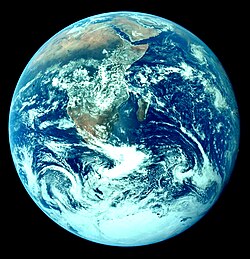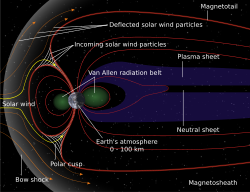Solar System/Earth
| This page or section is an undeveloped draft or outline. You can help to develop the work, or you can ask for assistance in the project room. |

Earth is the third planet from the Sun and has a diameter of 12,756 kilometers, making it the fifth largest planet. It is the only place in the universe where at this time life is known to exist. Earth is one of the four terrestrial planets (planets having a solid surface).
Physical characteristics
[edit | edit source]Shape
[edit | edit source]The diameter of the Earth at the poles is 44 kilometers less than its diameter at the equator.
Orbit
[edit | edit source]
The orbit is nearly circular, with an eccentricity of only 0.0167. Earth orbits the Sun once every 365.2422 sidereal days (rotations relative to the distant stars) at an average distance of 149,597,870 kilometers, and this distance is defined as one AU (astronomical unit). This distance is often expressed approximately in terms of miles as 93 million miles. Earth is at its closest to the Sun each year (that is, is at perihelion) at a time in the range January 2 to January 5, and is farthest from the Sun (is at aphelion) at a time in the range July 4 to July 7. Light from the Sun takes an average of 499 seconds (8 minutes 19 seconds) to get to Earth.
Rotation
[edit | edit source]The Earth rotates prograde (in the same direction as it travels around the Sun) relative to the distant stars once every 23 hours 56 minutes 4 seconds. Since the Earth is traveling around the Sun during this time, it takes an extra 3 minutes 56 seconds to complete a rotation relative to the Sun; so the solar day is 24 hours long. (Indeed, the "hour" is defined as 1/24 of a solar day.)
Earth's axis is tilted by 23.45° relative to the perpendicular of its orbital plane. This tilt is what causes seasons to occur on Earth. (Since Earth's orbit is virtually circular, the minor variations in the distance from the Sun are not the cause of the seasons.) The longest day of the year in the northern or southern hemisphere occurs at the time in the orbit when points on the Tropic of Cancer or Tropic of Capricorn (23.45° north or south latitude) are pointed directly at the Sun at noon (so the Sun appears directly overhead). This time is known as the Summer Solstice in that hemisphere and the Winter Solstice in the opposite hemisphere. The times when the points on the equator are pointed directly at the Sun at noon are called the equinoxes, because at those times all points on Earth experience 12 hours between sunrise and sunset and 12 hours between sunset and sunrise.
Gravitational field
[edit | edit source]
Atmosphere
[edit | edit source]Atmospheric layers
[edit | edit source]The stratosphere and the ionosphere
[edit | edit source]Clouds
[edit | edit source]Climatic variations
[edit | edit source]The Crowded Sky Above Us
[edit | edit source]Surface
[edit | edit source]
Continental drift
[edit | edit source]Impact Craters
[edit | edit source]Oceans
[edit | edit source]The Earth's interior
[edit | edit source]
A journey through the Earth
[edit | edit source]The magnetic field and the magnetosphere
[edit | edit source]
